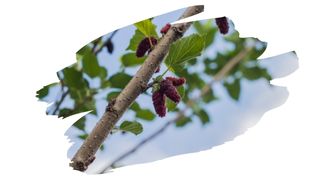Not all types of wood are created equal, when it comes to your indoor fireplace.
Some don’t burn quite as hot as others. And some can even pose a health risk if burned — either to your health or to the safety of your home.
When it comes to picking out a decent firewood log — one that will burn long enough to really heat things up — then wood density matters. And that is something that Mulberry wood in particular, has in spades.
Now, if this all sounds new to you, then keep reading. That’s because, in this post, you’ll learn why Mulberry can be better for heating your home than even Oak or Birch wood. You’ll also discover what you need to be on the look out for, when it comes to choosing firewood.

This post may contain affiliate links to products that we receive a commission for (at no additional cost to you). Learn more here.
What Type Of Wood Generally Burns The Cleanest?
Good firewood is dry, and it doesn’t have a lot of tree sap/pitch in it. And, most importantly, good firewood should not come from a toxic tree species.
In addition to this, if you want your firewood log to burn hot, it needs to also come from a tough and dense wood species.
With all these things in mind, it’s little wonder that White Oak and Birch are the best choices for firewood. Both of these hardwoods are tough and dense, producing a significant amount of heat as they burn. Plus, they are non-toxic, and contain little sap.
Related Post: Is Birch Wood Good For Smoking Meat?
What About Smoke? Do These Firewood Choices Produce A Lot Of Smoke?
If firewood is still fairly damp, then it will produce a lot of thick smoke. That is because the moisture in them will vaporize in the fireplace, making the smoke released even thicker.
So, if you want to keep smoke levels as low as possible, you need to only use dry firewood as fuel. Dry wood, (technically referred to as seasoned wood), has a low enough moisture content that excessive smoke isn’t an issue.
You can discover more about seasoned wood, (and how to speed up drying), by checking out our post: How To Season Wood (7 Tips)
What Does ‘Moisture Content’ Mean? Moisture content measures how much water is in a piece of wood. Freshly logged timber has a moisture content of around 100%. And, after wood’s been seasoned, that moisture content will have been whittled down to less than 20%.
And What Kind Of Wood Should You Avoid Throwing Into Your Indoor Fireplace?
Toxic tree species, such as the Yew tree, should not be chopped down for firewood. That’s because the poisonous compounds in these trees can collect both in the fumes and soot produced by burning them. And the last thing you need is any of that toxic soot/fume floating around your home.
However, one of the biggest fire risks in the home comes in the form of chimney fires. Chimney flues can become backed up and blocked, and this can cause a chimney to catch light.
Now, wood that contains a lot of tree sap/pitch, can contribute to chimney fires. That is because tree sap/pitch can gum up the soot inside your chimney flue. And that in turn can block your chimney.
This is why you need to avoid burning wood that has a lot of tree sap or pitch in it. Wood types such as Cedar and Pine, for example, are terrible firewood choices, namely because of their high sap/pitch content.
Alright, But What About Mulberry Wood? Is It Safe To Burn?
It is perfectly safe to burn Mulberry wood in your fireplace. In fact, Mulberry wood is probably one of the most benign timbers you can have in your home. It’s not only non-toxic to humans, it’s also non-toxic to cats, dogs and horses.
And in addition to it not being poisonous, this hardwood doesn’t contain much tree sap/pitch. So, it doesn’t pose a chimney fire risk either.
Related Post: Is Mulberry Wood Good For Smoking Meat?
But Will Mulberry Wood Produce Enough Heat?
Absolutely. In fact, Mulberry wood will burn as hot as the best of them. Based on the BTU (British Thermal Unit) rating of this wood, it produces about as much heat as Oak or Birch.
You see, the BTU rating measures how much energy it takes to burn a cord of firewood. The more energy it takes to burn something, the more heat is produced.
Mulberry wood has a 25.8 BTU rating. That means that Mulberry wood releases more heat than Birch (23.6 BTU), and even White Oak (25.7 BTU).
So, as long as you give Mulberry wood time to season, it can be safely used in your fireplace.
Related Post: Is Hackberry Tree Wood Good For Firewood?
And How Long Will It Take For Mulberry Wood To Season?
It’ll take this lumber anywhere from 6 months to 12 months to season.
Nevertheless, if you freshly log the tree in the heat of summer, it should be dry enough by winter.
To Wrap Up, Here Are The 3 Key Takeaways From This Post…
- 1). An indoor fireplace should be fueled with firewood that is non-toxic, fairly dense, and low in sap.
- 2). Mulberry fits the bill on all three counts. What’s more, it even produces more heat than White Oak or Birch wood.
- 3). Only use dry seasoned Mulberry wood in your fireplace. This will help keep smoke emissions to a minimum.
References:
Wood Smoke Awareness | EPA.gov
Mulberry Tree | ASPCA.org



